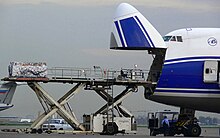Trepel Airport Equipment
| Trepel Airport Equipment GmbH
|
|
|---|---|
| legal form | GmbH |
| founding | 1946 |
| Seat | Tauberbischofsheim , Germany |
| management | Werner Berger, Carsten Schimkat |
| Number of employees | 57 |
| sales | EUR 109.86 million |
| Branch | Aviation ground support equipment |
| Website | www.trepel.com |
| As of December 31, 2018 | |
The Trepel Airport Equipment GmbH (short: Trepel ; own notation: TREPEL Airport Equipment GmbH , shortly TREPEL or TAE ), headquartered in Baden-Württemberg Tauberbischofsheim is a global manufacturer of aerospace ground equipment ( English ground support equipment ). The distribution is located in Wiesbaden .
history
The company was founded by the then owner Ingo Trepel in 1946 in Wiesbaden as a repair shop for machine tools . In 1956, with the development of the first scissor lift tables , another important chapter in the company's history began, with which the name Trepel is sometimes still associated today. For their wedding, lift table designs were also implemented for export with a load capacity of up to 500 tons.
With the appearance of the first wide-body aircraft in 1963, the production and worldwide sales of catering vehicles began. A decade later, the first aircraft loader with a load capacity of 12,000 kg was demonstrated. Shortly afterwards, the first mobile lounges were delivered, which combined the function of an airplane staircase, a bus and a gate . In 1985, the founder Ingo Trepel retired and PHB Weserhütte AG took over the company.
In order to allow for the steady growth of the airport sector, the production of this branch of the company was relocated from Wiesbaden to Tauberbischofsheim (Baden-Württemberg) in 1991. In close proximity and in cooperation with the sister company MAFI Transport-Systeme GmbH , the location was entrusted with the production of the entire airport division. In 1996 this was outsourced from Trepel GmbH (in Wiesbaden) to the independent Trepel Airport Equipment GmbH , which was based in Tauberbischofsheim. The sales of the new company remained as an independent branch in Wiesbaden. In the years after 1996, through continuous investments and further expansion stages, the production capacity was further increased, so that the entry into aircraft tractor production began with the Challenger700 model . According to the company, Trepel vehicles are operated at airports in over 150 countries.
Products
The product range includes pallet / container loaders, loader transporters and transporters for handling so-called unit load devices . Furthermore, aircraft tugs for towing and pushback are mainly manufactured for wide-bodied and narrow - body aircraft .
In the area of the aircraft loader (typically with a front and main platform), Trepel covers all international sizes for the lower deck (3,500 kg and 7,000 kg load or lifting capacity) or for the so-called main deck ( cargo aircraft or Combi versions ) (14,000 kg, 20,000 kg, 30,000 kg and 35,000 kg load or lifting capacity). The CHAMP350 aircraft loader has been the only 35,000 kg main deck loader available on the market for several years since its launch in 2008. The CHAMP200 (20,000 kg load), an older model, is particularly popular in Asia and, thanks to its main platform without standing lifting cylinders, is particularly suitable for docking with Soviet-style cargo planes, otherwise the fuselage or the open ones when the tail or nose is loaded Hatches could be damaged by protruding lift cylinders . The volume model for the loaders is the CHAMP70 (7,000 kg load) in its (commercially available) versions S ( Standard ), W ( Wide ) and U ( Universal ), of which the latter can also serve the main deck with restrictions.
The sizes of aircraft tugs are specified by the respective aircraft manufacturer in the so-called ground towing requirements and range up to 70,000 kg permissible total mass . Trepel originally covered this spectrum with the three bar haulers Challenger 160, 430 and 700. Currently (2015) the five variants Challenger150, 280, 430, 550 and 700 selectively represent this area through adjustable ballasting. The Challenger150 (max. 16,000 kg) is a pure volume model, especially designed to push back the Airbus A320 family as well of the Boeing 737 variants. The largest vehicle is the Challenger700 (max. 70,000 kg), which measures approx. 9,300 mm when fully equipped (front and rear driver's cab) without couplings. It was the first aircraft tractor with a height-adjustable hydropneumatic front axle suspension and an engine compartment that could be hydraulically extended for maintenance purposes. Its typical purpose is the pushback of aircraft up to 600,000 kg MTOW (maximum take-off weight) such as the Airbus A380 . Since Airbus has postponed its A380F freight version for an indefinite period, the development of the Challenger700 was limited to a two-axle variant with appropriate ballast and engine power. Finally, a unique selling point of the model is the selectable delivery option of two different driver's cabs, which differ greatly in terms of concept and appearance.
Web links
Individual evidence
- ↑ Imprint
- ↑ a b Bundesanzeiger, Trepel Airport Equipment GmbH: Annual financial statements for the financial year from January 1, 2018 to December 31, 2018 . In: Federal Gazette
Coordinates: 49 ° 38 ′ 1.7 ″ N , 9 ° 39 ′ 9.8 ″ E







